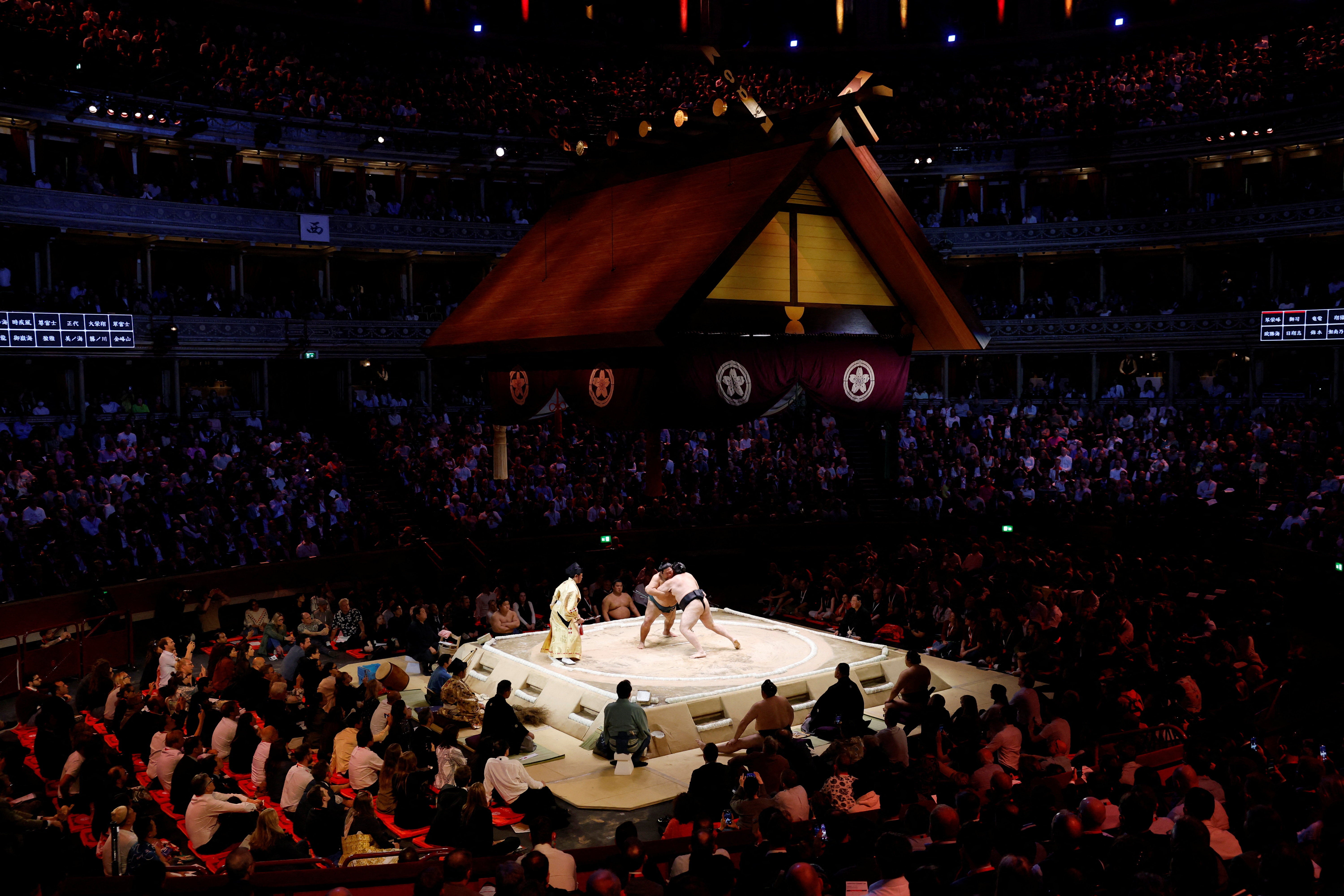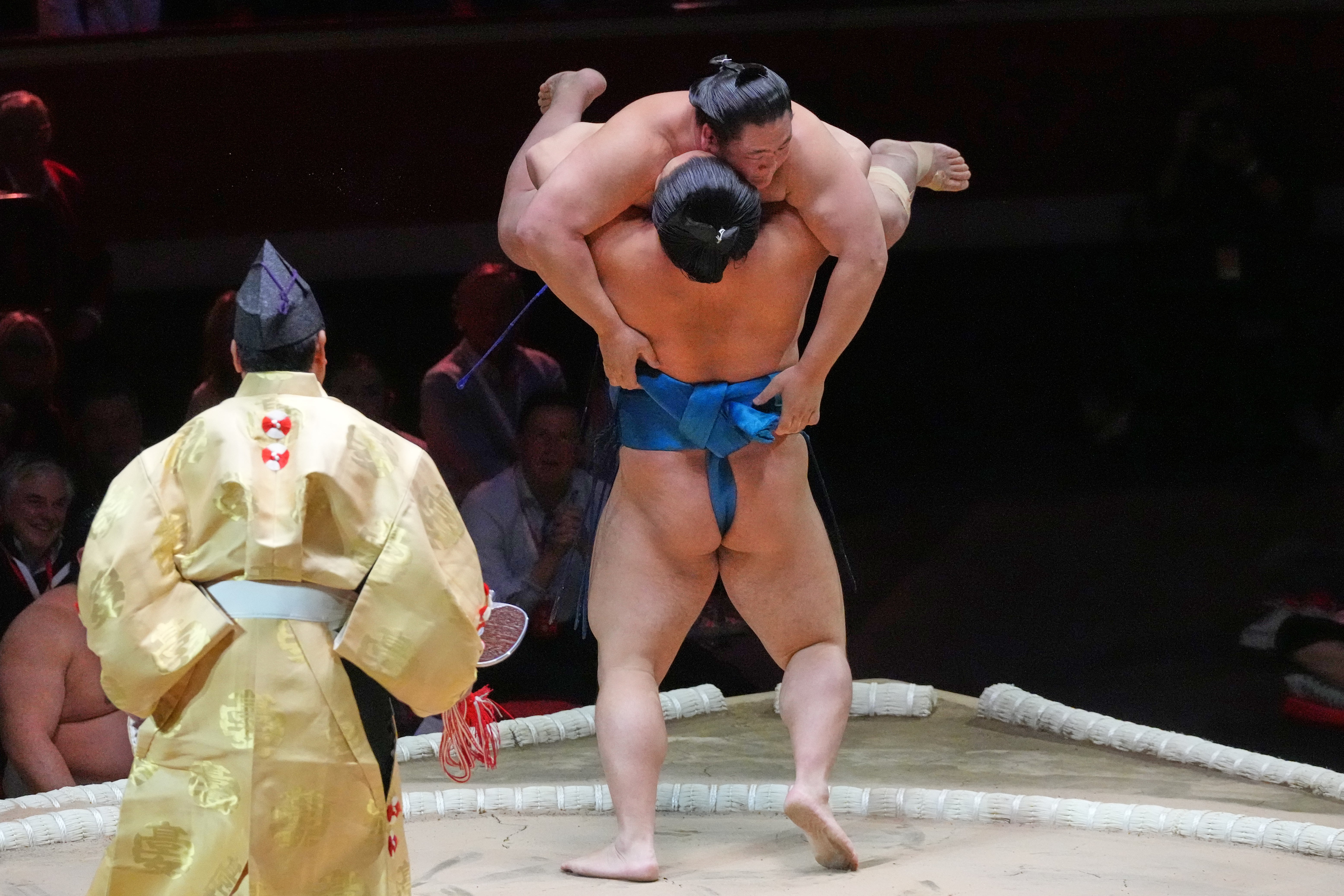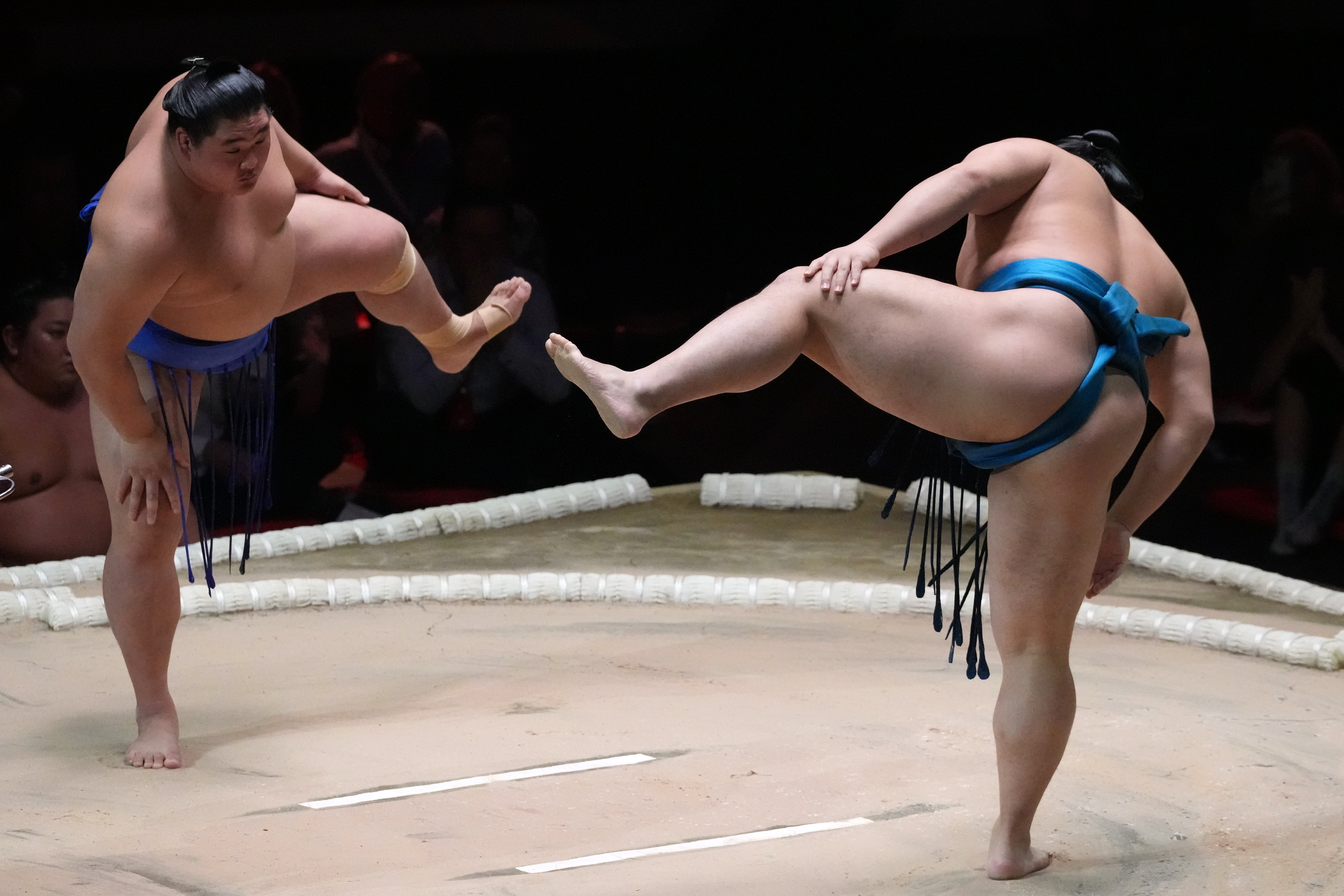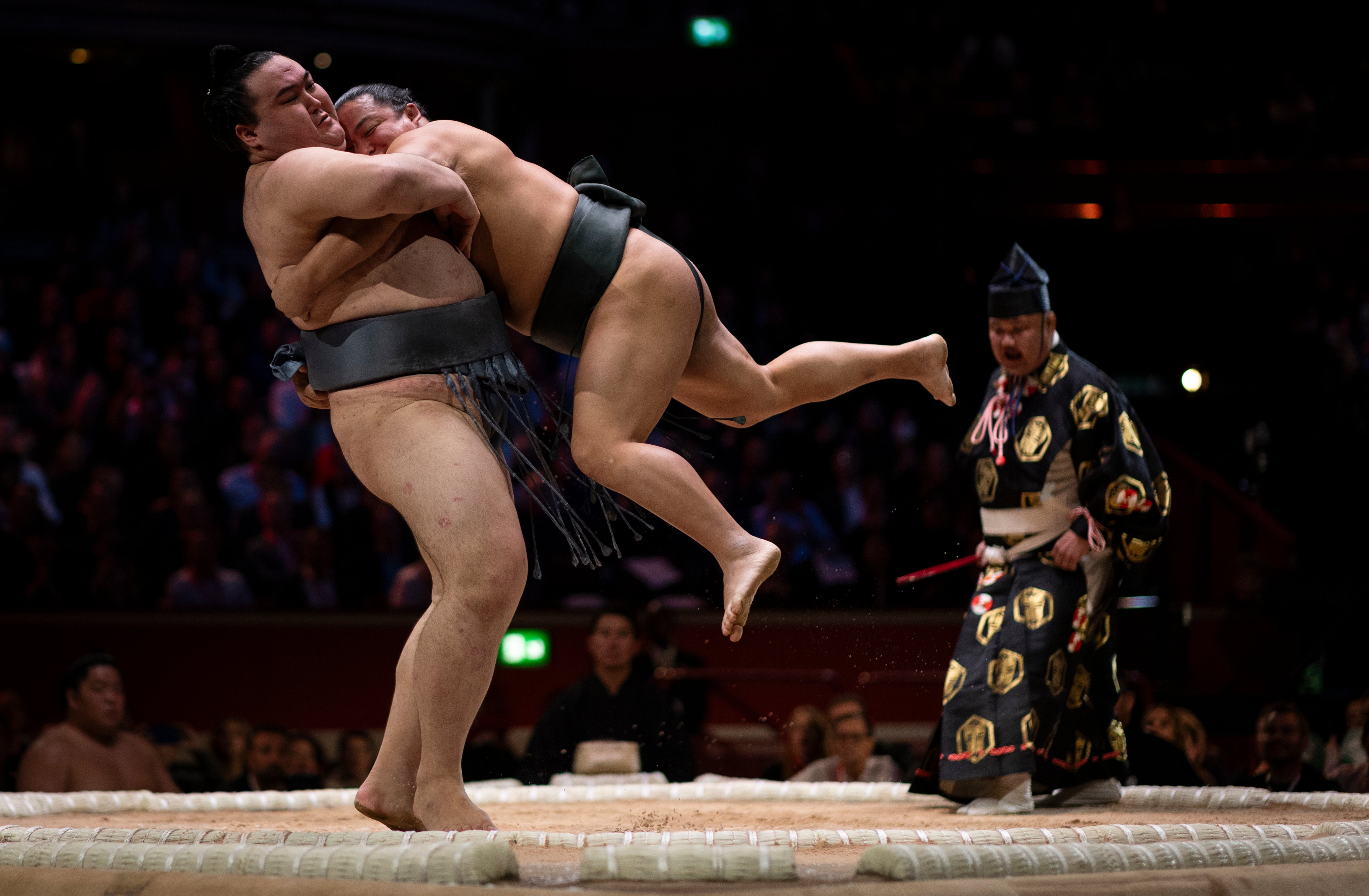Sumo comes to London as rituals, evil spirits, and Lime bikes define unique week for Japan’s national sport

As photos circulate on social media of Sumo wrestlers riding Lime bikes and recreating the cover of The Beatles’s Abbey Road, a question springs to mind: is there a more enigmatic sport than Sumo? A more widely known yet less consumed sport, internationally?
Indeed, Sumo (the “wrestling” is effectively redundant in the translation) has thundered throughout worldwide popular culture for decades, and yet its actual competitions have been almost exclusively contained to its native Japan. In a historic turn, this week marks just the second time ever that a professional Sumo contest is being hosted abroad. How’s that for a stat?
Sumo has made a miraculously rare excursion overseas, as London’s Royal Albert Hall receives the honour of hosting the Grand Sumo Tournament. The sport’s only prior international event also took place in the ornate, iconic London venue, in 1991. Yet upon setting foot in the Albert Hall, it becomes immediately, starkly clear: the protagonists of this event are not the guests here; rather, as an onlooker, one feels a guest to an entire culture.
That cannot be said of the Japanese fans present, of course, and there are many of them. But such is the emphasis on the rituals around Sumo that there is something transportive about this event – and even the Japanese in the stands surely feel that transportive essence, too.
It fills the stunning, cylindrical room from the very first second of the afternoon’s blessing of the ring, which is admittedly closed off to fans but to which The Independent is fortunate to be invited. It fills the room through the percussive click of two wooden blocks gently clacking together.
After the echo of that sound, a strange stillness reigns over the Albert Hall. It is almost disconcerting, only in as much as British fight sports are so often soundtracked by screams and swears, not silence.
Three men in traditional Japanese gowns and headwear conduct this ritual. They wave leaved branches, deliver hymnic recitations, and pour small amounts of liquid onto the clay ring, among other small acts – some punctuated by bows, but every one of them deliberate, performed so slowly so as to elicit maximum emphasis. Throughout, items, as is traditional in Japan, are presented and received with two hands as a sign of full focus and care. Later in the blessing, a drum is carried around the ring, polyrhythms booming from its skin and twitching out of its wood.
This absorbing series of scenes only serves to enhance the significance of what follows, the actual competition, framing the combatants not as athletes but something much more: genuine warriors. The emphasis on respect in Japanese culture means any venue less regal than the Albert Hall, which is full tonight, would feel unfitting for an occasion such as this – insulting, almost.
The action itself begins with the rikishi (wrestlers) scattering salt to purify the dohyo (ring), before charging at one another (tachiai) upon the signal of the gyoji (referee). The very first collision of the night draws an almighty gasp from the crowd, giving way to giddy applause upon the resolution of the match.
The aim, as you may know, is for one rikishi to push the other outside of the rope circle laid around ring, or to force them to touch the ground with any body part other than the soles of their feet. They must not punch, kick, headbutt, or grab their opponent’s top knot.


Ringside, five judges – retired rikishi, dressed in formal kimono – sit and can raise a hand to contest the gyoji’s decision, if they so wish. The prize money on offer, it seems, is up to 60,000 Yen (£300) per bout, although there are sponsors, too. (On this note, tickets are going at more than £300 now, and some fans sit cross-legged at ringside, on square red pads.) And if a lower-ranked rikishi defeats a yokozuna (the most-elite level of wrestler), they earn a gold star that guarantees a monthly bonus for the rest of their career. Handy.
Speaking of handy, a booklet outlines the various kimarite (winning techniques), more than 20 of which are listed. And in this way, for what you might assume is a one-dimensional sport, the patterns of the contests can vary quite significantly.
We see rikishi hoisted via a double inside grip and dropped on the outside of the rope. We see them off-balanced and hurled at an angle with techniques reminiscent of those in Judo. Tumbling out of the ring and down the step. We see one-sided fights that are over within three seconds, and we see back-and-forth duels in which both rikishi are slid back on their heels before a victor emerges. That said, even the longest matches tend to go no longer than 10 seconds.
None of this can occur before salt is used to purify the ring and body, however; salt is believed to have the power to dispel evil spirits. Similarly, the famous Sumo shiko (stomp) is meant to deter evil spirits lurking underground – although it is also used as a leg strengthening exercise – and the seismic clap is to call the attention of the gods and show no weapons are being held.

“Sumo began as a ritual, long before it became a sport,” says co-host Hiro Morita, known as the English voice of sumo. “Every moment has deep ties to Shinto meaning and rituals,” he says, adding that Sumo was originally a way to pray for a rich harvest.
Surprisingly, there are just 600 professional rikishi, and there have only ever been 75 yokozuna, in the 250-plus years since the ranking system was created. Remarkably, two are competing in this competition. In fact, the chairman of the International Sumo Federation is Hokutoumi Nobuyoshi, who won the 1991 tournament in this same venue.
Between bouts, the winner offers a ladle of water – “the water of power” – to the next combatant from the same side of the ring as them. Those sides are labelled “east” and “west”.
This is a lot of information to take in, yes, but it is worth saying that a surprisingly strong British contingent in the stands is already aware of these traditions. Many of them cheer the introductions of specific rikishi with particular fervency, showing their understanding of the sport’s landscape.

Some rikishi engage in greater showmanship than others, burying their colossal fists into the salt boxes like JCB diggers before scattering hailstorms of the grains with a flourish. What is uncannily consistent, however, is the waddle as the competitors move around the arena between fights. Yet this waddle gives way to a unique athleticism in the dohyo.
What is also consistent is the way newer fans are lured in by the pre-match face-off (shikiri). Such is the intensity of this moment, engrossed fans let out a sudden laugh when the rikishi break apart at the final second to gather more salt. No matter how many times it happens, it elicits a reaction without fail.
And the event itself elicits joy without fail. Your first Sumo experience will be as educational as it will entertaining, lifting the lid on the world’s most-enigmatic sport – and thrusting you into another culture entirely.
The remainder of the Grand Sumo Tournament, 16-19 October, streams live on DAZN, Pluto TV, and the BBC (iPlayer, Red Button, BBC Sport website and app).




